Little beetle, big horns
Why do dung beetles have horns? Biologists sniff out some answers.
By Roberta Kwok
A dung beetle is squirming in my hand. It’s only the size of my pinky fingernail, but I can feel its spiny legs poking my skin.
I try not to think about where those legs have been. Why? Because I know that Armin Moczek, a biologist at Indiana University at Bloomington, just dug up the beetle from a container of dirt and cow manure.
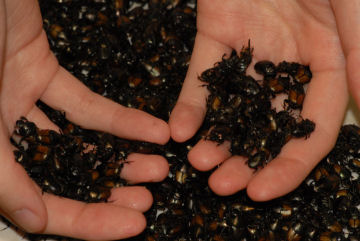 |
|
Roberta Kwok holds dung beetles in her hands.
|
| Armin Moczek |
Moczek studies beetles in his lab, and he takes good care of his bugs. “We go out every couple of months, collect a lot of cow dung, freeze it, defrost it as needed, and feed it to them,” he explains.
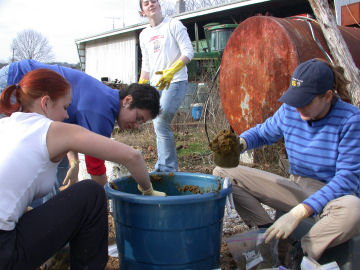 |
|
Caring for dung beetles is dirty work. Moczek’s lab members—including (from left to right) Melanie O’Day, Debra Rose, Bethany Kesselring, and Morgan Peters—have to scoop cow manure into bags.
|
| Armin Moczek |
Moczek doesn’t mind the beetles’ smelly diet. He’s focused on what makes beetles unique in the insect world: their ability to grow horns.
Scientists have recently discovered that beetles use their horns in surprising ways. And, says Moczek, there’s still a lot to learn about how beetles evolved horns in the first place.
“We have a pretty good idea of what needs to happen for legs to become longer, or wings to become wider,” he says. But scientists don’t know how animals develop a completely new body part. Studying how beetle horns evolved might help answer that question.
Horn-to-horn combat
Beetle horns come in a variety of shapes and sizes. Some beetle horns snap together, like pincers. Others are low and curved, like an elephant’s tusk. And watch out—a dung beetle’s horns can be longer than the rest of its body.
In fact, some horns are so big that “it looks like the beetles are going to tip over,” says Douglas Emlen, a biologist at the University of Montana-Missoula who also studies beetles.
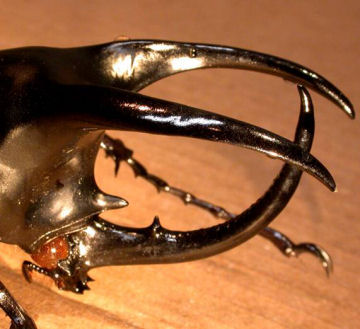 |
|
A beetle’s horns can weigh more than one-third of its entire body weight.
|
| Armin Moczek |
In most species, only the male beetles grow full adult horns. They use their horns to fight for mates. A horned male will guard the entrance to a tunnel housing a female and fight off intruders.
Beetle horns can be impressive weapons. Beetles use their horns to grab other beetles, lift them in the air, and even throw them off trees. Sometimes a beetle will slide its horn underneath another beetle and flip it over. “They beat each other up,” says Moczek.
But some of the smaller males don’t grow horns at all. Emlen says that instead of fighting for mates, these beetles use “sneaking behavior.” As an unsuspecting horned male stands guard at the entrance to a female’s tunnel, a hornless male digs a horizontal side tunnel that connects to it. He finds the female underground, mates with her, and sneaks away before the guard notices.
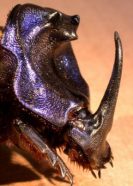 |
|
Dung beetles’ horns come in a wide array of shapes and sizes.
|
| Armin Moczek |
Emlen thinks that hornless males might be naturally better at sneaking through underground tunnels than the horned beetles are. Large horns can slow a beetle down because they scrape the tunnel walls. And without horns, a beetle might run faster and more quietly underground.
Baby horns
Scientists have studied adult-beetle horns for a long time. But Moczek found something surprising when he looked at immature beetles, called larvae. In the species that he studied, the large male larvae grew horns—but so did the female and smaller male larvae. When these beetles matured, their horns disappeared.
“You wonder why,” Moczek says. “Why bother making these structures?”
To answer this question, he raised beetle larvae in the lab. Larvae normally grow inside little balls of packed dung, called brood balls. Moczek made artificial brood balls for his beetles by collecting cow dung and squeezing out the moisture with cheesecloth.
“You don’t want to squeeze too hard,” he says, “because the cheesecloth will rip, and then you have projectile dung.”
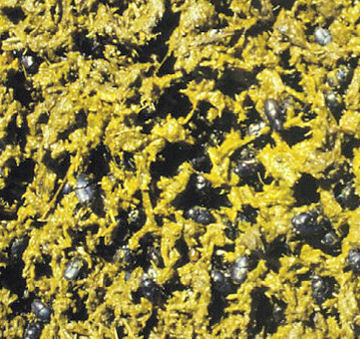 |
|
Beetles crawl around in cow dung. Some species eat the dung of horses, dogs, monkeys, and even millipedes.
|
| Armin Moczek |
Inside their cozy brood balls, the larvae grow thick, protective helmets called larval head capsules. But the larvae eventually have to break out of these capsules to become full-grown adults. Moczek noticed that the larvae seemed to use their horns to poke their way out of their capsules.
He tested his idea by zapping some larvae with electricity in the places where their horns normally appear. This stopped the horns from growing. Sure enough, these hornless larvae couldn’t shed their head capsules.
An eye for a horn
Beetles can grow horns in several places. Some horns are located on the front of a beetle’s face. Others grow from the back of the head. And still others grow from the thorax, which is between the beetle’s “shoulder blades.”
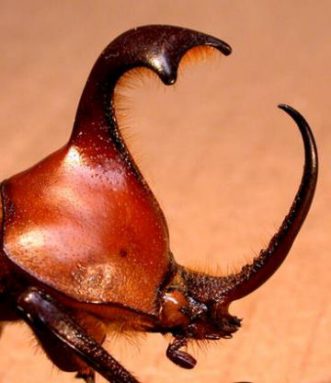 |
|
This beetle has one horn growing from its head (right) and another from its thorax (left).
|
|
Armin Moczek
|
Emlen discovered that the location of a beetle’s horns can affect the size of its other body parts. For example, a beetle with horns on the back of the head, near its eyes, often has smaller eyes than a beetle with no such horns. If the horns are on the front of the head, the beetle may have normal eyes, but relatively small antennae. And if the horns are on the thorax, the beetle has smaller-than-average wings.
This makes sense, because growing a horn takes a lot of energy. “The horns are expensive,” says Emlen. There’s a trade-off: If a beetle uses a lot of energy to grow a big horn, its nearby body parts won’t grow as much.
Going back in time
By studying how horns grow and how the beetles use them, scientists such as Moczek and Emlen are unraveling beetle history. Were the first horns used as weapons or as tools for opening larval head capsules? Did hornless males evolve because sneaking works better without horns or because horns take too much energy to grow? Thinking about horns “forces you to go back in time,” says Emlen.
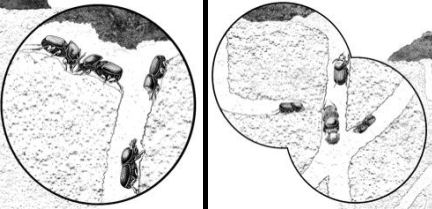 |
|
In the illustration at left, two horned males fight at the entrance to a tunnel. In the illustration at right, two hornless males try to sneak toward a female from the sides, while a horned male guards the top of the tunnel.
|
| Barrett Klein |
If you live near cows, you can find dung beetles on your own. Go to a pasture, put on some gloves, and peek underneath the cow droppings. You might see dung beetle tunnels—and, if you’re lucky, even some dung beetles.
Studying dung beetles can be fascinating. “You just need to get over the poop factor,” says Moczek.







